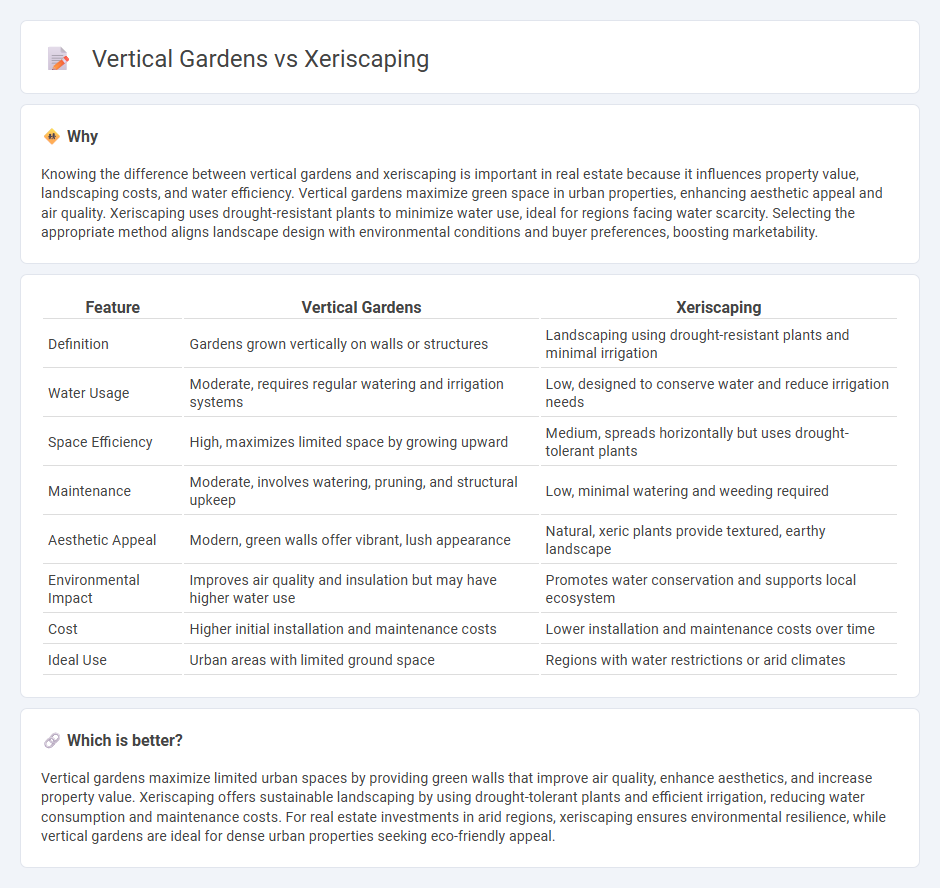
Vertical gardens maximize urban space by integrating lush, green walls that improve air quality and enhance property aesthetics, while xeriscaping emphasizes water-efficient landscaping using drought-tolerant plants to reduce irrigation needs. Both methods contribute to sustainable real estate development by promoting environmental conservation and increasing property value. Explore the benefits of vertical gardens and xeriscaping to discover which landscaping solution best suits your real estate project.
Why it is important
Knowing the difference between vertical gardens and xeriscaping is important in real estate because it influences property value, landscaping costs, and water efficiency. Vertical gardens maximize green space in urban properties, enhancing aesthetic appeal and air quality. Xeriscaping uses drought-resistant plants to minimize water use, ideal for regions facing water scarcity. Selecting the appropriate method aligns landscape design with environmental conditions and buyer preferences, boosting marketability.
Comparison Table
| Feature | Vertical Gardens | Xeriscaping |
|---|---|---|
| Definition | Gardens grown vertically on walls or structures | Landscaping using drought-resistant plants and minimal irrigation |
| Water Usage | Moderate, requires regular watering and irrigation systems | Low, designed to conserve water and reduce irrigation needs |
| Space Efficiency | High, maximizes limited space by growing upward | Medium, spreads horizontally but uses drought-tolerant plants |
| Maintenance | Moderate, involves watering, pruning, and structural upkeep | Low, minimal watering and weeding required |
| Aesthetic Appeal | Modern, green walls offer vibrant, lush appearance | Natural, xeric plants provide textured, earthy landscape |
| Environmental Impact | Improves air quality and insulation but may have higher water use | Promotes water conservation and supports local ecosystem |
| Cost | Higher initial installation and maintenance costs | Lower installation and maintenance costs over time |
| Ideal Use | Urban areas with limited ground space | Regions with water restrictions or arid climates |
Which is better?
Vertical gardens maximize limited urban spaces by providing green walls that improve air quality, enhance aesthetics, and increase property value. Xeriscaping offers sustainable landscaping by using drought-tolerant plants and efficient irrigation, reducing water consumption and maintenance costs. For real estate investments in arid regions, xeriscaping ensures environmental resilience, while vertical gardens are ideal for dense urban properties seeking eco-friendly appeal.
Connection
Vertical gardens and xeriscaping both promote sustainable landscaping by conserving water and enhancing urban green spaces. Vertical gardens optimize space by growing plants upward on walls, reducing soil use and irrigation needs. Xeriscaping complements this by using drought-resistant plants and efficient water management techniques, creating eco-friendly real estate environments that lower maintenance costs and increase property value.
Key Terms
Water Efficiency
Xeriscaping maximizes water efficiency by utilizing drought-tolerant plants and mulch to reduce evaporation, often achieving up to 50% water savings compared to traditional gardening methods. Vertical gardens optimize water use by incorporating drip irrigation and targeted watering systems, minimizing runoff and evaporation in limited spaces. Explore how these innovative landscaping techniques can transform water conservation efforts in your garden.
Space Utilization
Xeriscaping maximizes outdoor space by using drought-resistant plants that require minimal water and maintenance, ideal for arid climates and reducing landscape footprint. Vertical gardens optimize vertical space by growing plants on walls or structures, making them perfect for urban areas with limited ground space. Explore the benefits of both methods to discover the best solution for your space utilization needs.
Maintenance Requirements
Xeriscaping requires minimal irrigation, drought-tolerant plants, and occasional pruning, making it ideal for low-maintenance landscapes. Vertical gardens demand regular watering, fertilization, and monitoring of plant health due to limited soil volume and greater exposure to environmental factors. Explore more to understand which sustainable gardening method suits your maintenance preferences best.
Source and External Links
Xeriscaping - Wikipedia - Xeriscaping is a landscaping method that reduces or eliminates the need for irrigation by using plants suited to local climates and careful design to conserve water, aiming to save water and reduce maintenance especially in arid regions.
The benefits of xeriscaping: A beginner's guide to drought-tolerant landscaping - Xeriscaping applies seven core principles such as improving soil, using drought-tolerant plants, limiting turfgrass, and efficient irrigation to create a beautiful, low-water, low-maintenance garden that supports a healthy ecosystem.
Xeriscape - Board of Water Supply - Xeriscaping involves designing residential or park landscapes to minimize outdoor water use, potentially saving 30-80% of water consumption while maintaining attractive environments through soil improvement, phased planning, and efficient irrigation.
 dowidth.com
dowidth.com